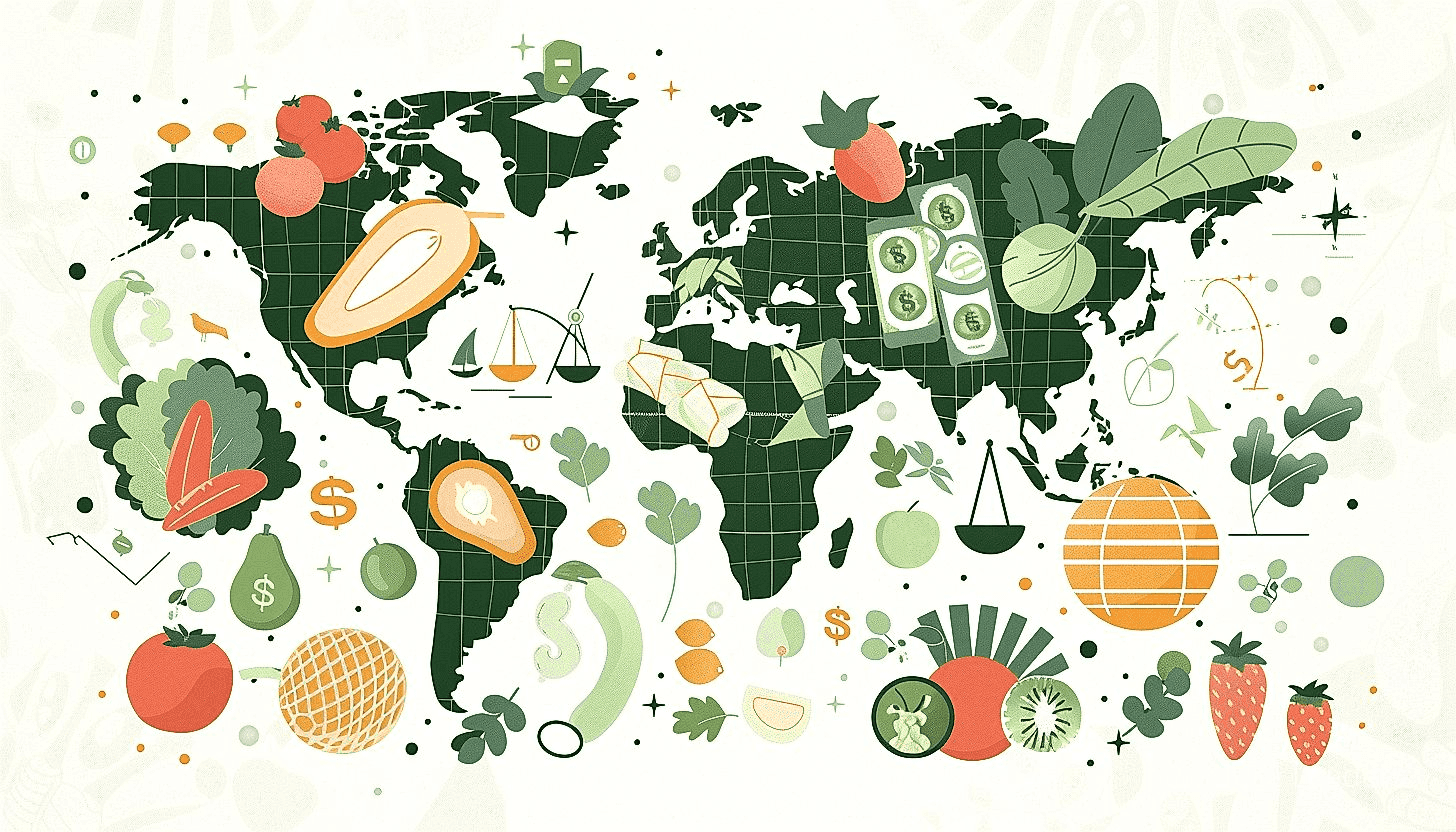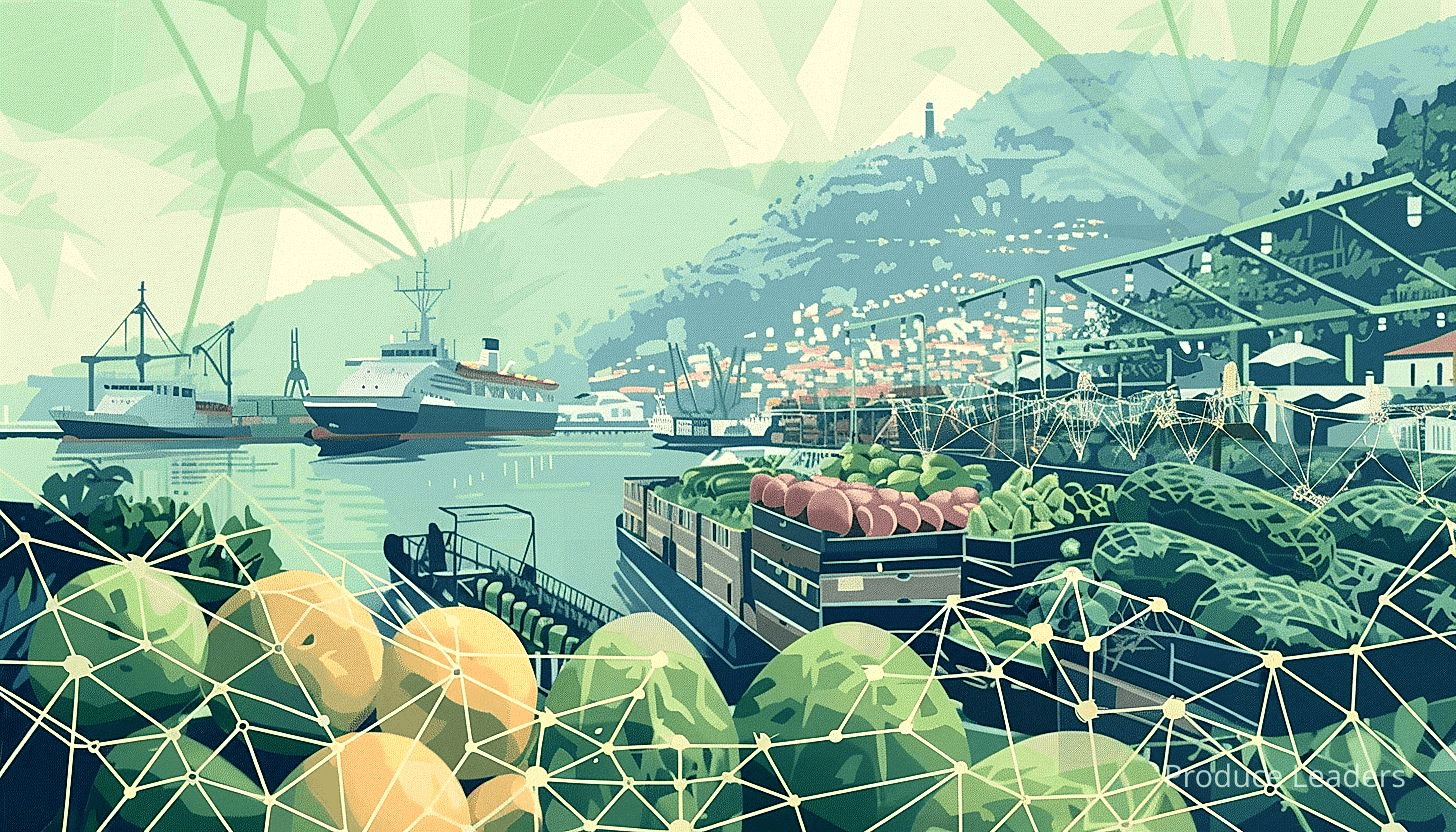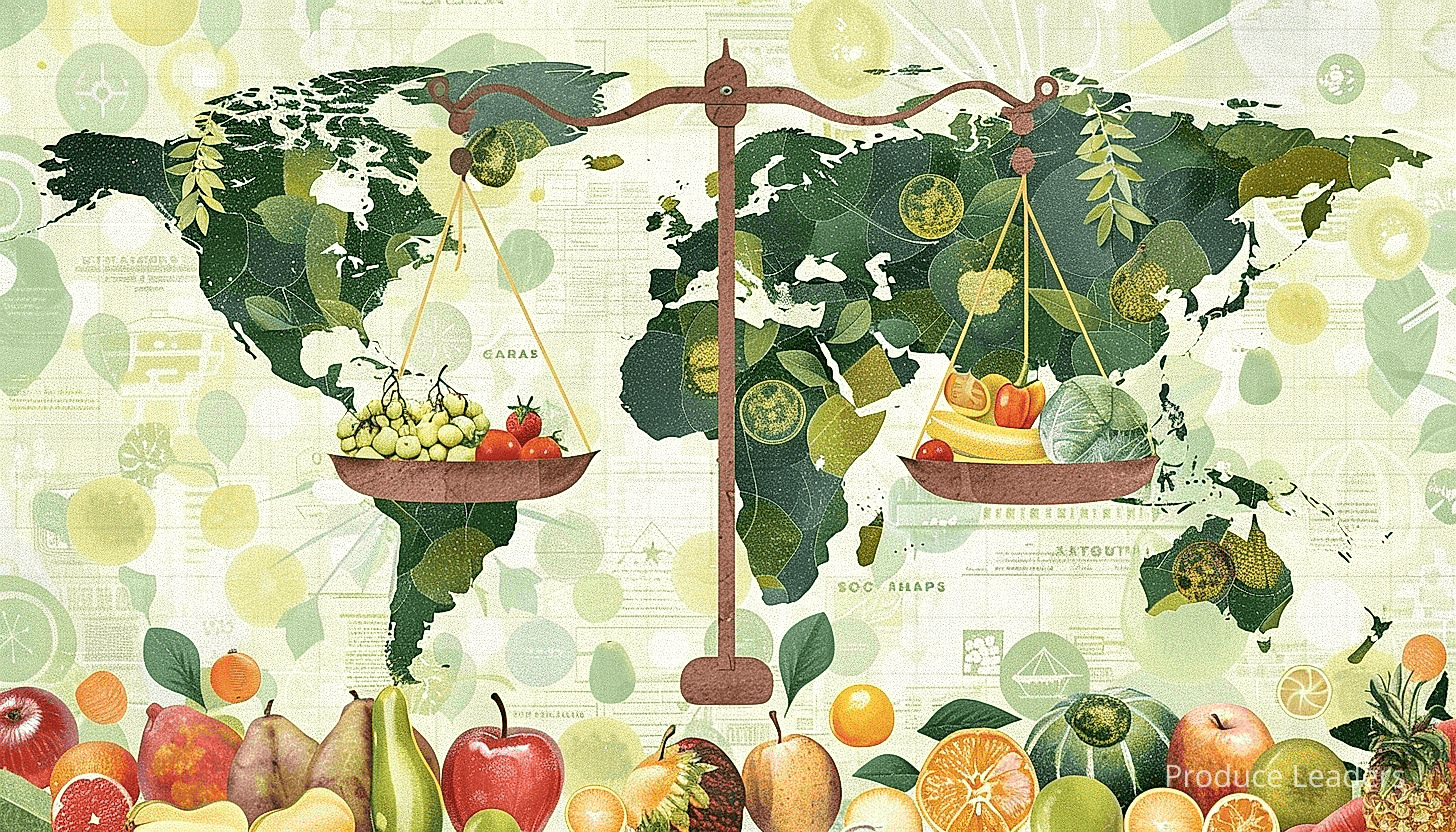Trade policies fundamentally shape how and what countries exchange on the global marketplace.
Their impact is particularly significant in the case of produce exports.
Fruit, vegetables and other agricultural commodities are staples of international trade, with vast quantities crossing borders daily.
Choices made by governments about tariffs, import quotas or trade agreements can significantly influence these commodities’ flux.
The patterns of cause and effect often weave complex, multifaceted narratives worth exploring.
The following examination is an effort to unwrap this subject by bringing a microscopic view to the often-overlooked implications of changes in trade policy.
- Trade policies enhance competition among nations.
- They significantly influence product prices.
- Global distribution patterns are impacted by such policies.
- Trade policies may lead to trade imbalances.
- Such policies can cause export diversification.
In the upcoming sections, we’ll extend our discussion to other relevant aspects related to trade policies. The additional subjects include the specific effects of these policies on the agricultural sector, as well as the broader economic implications that arise from them.
Having a comprehensive understanding of these topics will provide a more rounded view of the far-reaching impacts of trade policies. Let me tell you, let’s continue to deepen our understanding, as these insights can help shape our perception of the global trade landscape.
Contents
Impacts Of Trade Policies On Produce Exports
1. Enhances competition among nations
In Short: Trade policies dictate the competitive dynamics among nations in the global market by establishing trade agreements, promoting product standardization, influencing tariffs, and managing subsidies. A country’s ability to effectively formulate and adapt these policies to global trade changes can give it a competitive edge, driving international competition and global economic growth.
Trade policies are a significant element in the international trade landscape. The strategic formulation and implementation of these policies often determine the competitive edge of a nation in the global market.
Trade policies, akin to economic levers, shape the extent and nature of competition among nations. By setting guidelines for exports and imports, these policies regulate the terms of competition.
This regulatory function is instrumental in defining a country’s economic identity in the global scene. It determines its interaction with other nations and marks its landscape in the global marketplace.
We should note a few ways trade policies enhance competition among nations. Herein, we shall dig in into some of these mechanisms:
- Establishing trade deals or agreements: Trade policies can manifest in the form of bilateral or multilateral trade agreements that boost competition.
- Promoting product standardization: By stipulating the required standards for imported and exported goods, trade policies can level the playing field for all competitors.
- Influencing tariffs: Manipulation of trade tariffs can affect the competitiveness of particular goods or countries.
- Managing subsidies: Providing or withholding subsidies to certain sectors can carry a significant impact on their international competitiveness.
For instance, trade agreements are often crucial in enhancing competition. They allow nations to gain preferred access to the markets of their agreement partners. This access often results in a competitive advantage over other nations that may not be privy to the same benefits.
When nations can trade products freely or at significantly reduced costs, it stimulates competition by increasing the availability of a wide range of goods. More options inevitably mean more competition.
Moreover, the aspect of product standardization in trade policies also fosters competition. By stipulating required standards for goods, policies ensure all competitors are on a level playing field. This ensures that all players adhere to set guidelines, making competition fairer and healthier.
Similarly, the manipulation of tariffs and the management of subsidies also play pivotal roles. The control over tariff rates can serve as a competitive strategy to encourage or discourage the export of certain commodities. Likewise, subsidies can boost the international competitiveness of selected sectors by reducing production costs or pricing goods more competitively.
The interplay of these elements within trade policies creates a dynamic and often fluctuating competitive environment among nations. Countries continually reassess their strategies in response to the ongoing changes in global trade regulations and norms.
Thus, understanding the complex dynamics of trade policies is crucial for nations to navigate the rough seas of international trade. The ability to adapt swiftly and intelligently to new regulations can provide a competitive advantage in this global marketplace.
The intricate dance of competition in international trade, largely choreographed by trade policies, is always in motion. It is at once fascinating, challenging, and critically important to countries’ economic health. This competitive spirit, driven by well-devised trade policies, fuels global economic growth and prosperity.
2. Influences prices of products
In Short: Trade policies greatly influence global market product prices, with tariffs, quotas, and duties often resulting in cost increases. Such policies can also shift supply and demand dynamics, affecting the balance of competition and the pricing of both domestic goods and exports.
Trade policies undeniably play a significant role in influencing the prices of products in the global market.
Through the imposition of tariffs, quotas, and import duties, trade policies can increase the cost of products.
This is due to the additional expenses that exporters may incur in the process of complying with these policies, which are inevitably passed on to consumers in the form of higher product prices.

Additionally, trade policies can also indirectly influence product prices by affecting supply and demand dynamics.
The sanction of import restrictions on certain goods, for instance, can cause a decrease in supply, resulting in increased prices.
On the other hand, removing trade barriers and entering into free trade agreements can lead to an increase in the competition among suppliers, potentially leading to lower prices for consumers.
Now let’s take a closer look at how trade policies, by acting on the factors above, can define the different price points for produce exports:
- In the case of tariffs and import duties, these additional costs are often incorporated into the product’s final retail price. This can lead to higher prices for consumers, especially if the product in question cannot be locally produced or sourced. The same happens with quota restrictions, as they limit the availability of a product, leading to a potential increase in its price.
- On the contrary, free trade agreements can act as a catalyst for price reduction. With the removal of trade barriers, goods and services can flow more freely between countries, potentially increasing competition among suppliers and lowering prices. In this scenario, locally produced goods can also benefit, as produce exporters can access new markets and consumers, leading to increased sales and revenue.
However, it is important to note that the impact of trade policies on product prices is not always straightforward.
The most geopolitical and economic contexts of the countries involved can have significant implications.
Subsidy programs and domestic agriculture policies can complicate matters by influencing local market prices, affecting fair competition, and causing price distortions in international markets.
Moreover, the impact of exchange rate fluctuations cannot be overlooked in any discussion about the influence of trade policies on product prices.
A decrease in the value of a country’s currency can make its exports cheaper, potentially driving down the prices of its exported products, even amidst restrictive trade policies.
Conversely, an appreciation of the nation’s currency can make its exports more expensive, countering the potential price-lowering effects of free trade agreements.
The apparent complexity of these influences reinforces the importance of understanding the varied effects of trade policies on product prices.
Such understanding is crucial not only for policy makers who design and implement these policies, but also for exporters and consumers who bear their impacts.
3. Impacts of Trade Policies on Global Distribution Patterns
In Short: Trade policies greatly influence global distribution patterns, impacting everything from local retailers to global conglomerates and redirecting international goods markets. Policies such as tariffs, quotas, domestic subsidies and rules promoting free trade can reshape global distribution routes, affect foreign direct investments and alter a nation’s economic structure.
Trade policies play an undeniable role in shaping global distribution patterns.
They are often adopted by countries to protect their domestic industries from foreign competition. However, they can also alter the flow of goods across the globe.
Their impacts can be felt on a myriad of levels, from the local retailer to global conglomerates.
Essentially, trade policies can create ripples in the international goods market and affect global distribution systems.
One notable instance of this is the imposition of tariffs and quotas by countries on imported goods.
This can significantly impact how countries decide to distribute their goods and allocate resources for their production.
Especially when high tariffs and strict quotas encourage the production and distribution of goods within their borders as opposed to relying on imports.
Now let’s dig in into some ways how trade policies directly influence global distribution patterns:
- Firstly, protectionist policies like tariffs can prompt countries to seek out alternative markets for their goods besides those with the imposed tariffs – thus re-routing global distribution paths.
- Secondly, trade policies that promote freer trade can boost cross-border trade, affecting global distribution networks by opening up more routes and markets.
- Thirdly, subsidies for domestic industry can also have effects on global distribution by bolstering domestic production, thereby affecting the volume of goods that a country needs to import.
Moreover, trade policies can also indirectly shape global distribution by influencing foreign direct investments (FDI).
For instance, trade policies that promote a conducive business environment can attract more investors to invest in the country. This may lead to increased production and followingly, changes in the distribution patterns of goods.
On the flip side, restrictive trade policies might discourage multinational companies from setting up manufacturing units in a country, affecting the distribution of goods produced by these companies across the globe.
However, it is important to note here that the impacts of trade policies on global distribution patterns are not always straightforward nor are they the same everywhere.
Factors such as a country’s geographic location, economic standing, and infrastructure system can also shape the ultimate impact of these policies.
Pro Tip: Trade policies significantly shape global distribution patterns, affecting everything from local retailers to global conglomerates and directly influencing a country’s decision to distribute goods, allocate resources, and attract foreign investment.
Indeed, trade policies can and do have significant and far-reaching effects on global distribution of goods.
An understanding of these impacts becomes crucial for policy makers, exporters, and investors alike in making informed strategic decisions about their trade practices and investment ventures.
4. May cause trade imbalances
In Short: Trade policies can potentially create trade imbalances, such as trade surplus or deficit, due to restrictive regulations like high tariffs and subsidies for domestic farmers. While short-term trade imbalances might benefit the country with a trade surplus, long-term imbalances may result in economic instability, impacted living standards, and dependency on export-based income.
One of the significant impacts of trade policies on produce exports is that they can potentially cause trade imbalances.
In the context of international trade, a trade imbalance occurs when the value of imports and exports between two nations is not equal.
One country may end up exporting much more than it imports, leading to a trade surplus, while the opposing country experiences a trade deficit.
Trade imbalances can arise due to various factors, one of which could be the presence of restrictive trade policies.
For instance, if a country places high tariffs or taxes on imported produce, it may discourage imports, thus leading to a potential imbalance in trade.

Alternatively, subsidies given to domestic farmers for produce export could also create a trade imbalance, as this policy may lead to an increase in exports at the expense of imports .
Now let’s discuss a few examples of how trade policies can lead to trade imbalances:
- Protectionist policies: These policies favor domestic industries over foreign ones, thereby discouraging imports and creating a trade imbalance.
- Export subsidies: These subsidies encourage more exports, potentially leading to a trade surplus and therefore a trade imbalance.
- High tariffs: Import tariffs make foreign goods more expensive, discouraging imports and leading to a trade imbalance.
An important point to note is that trade imbalances are not inherently negative.
In the short term, they can benefit the country with a trade surplus. However, long-term trade imbalances can lead to economic instability and financial crises for both the surplus and deficit nations.
Trade imbalances can stifle the growth of a country’s domestic industries, increase unemployment rates, and even create a vicious cycle of economic dependency on export-based income.
Additionally, countries with chronic trade deficits often have to take on significant debts to finance their import expenditure, leading to further economic instability.
Pro Tip: When formulating trade policies, aim for balance and fairness to prevent long-term trade imbalances which can lead to economic instability and financial crises.
Lastly, a country with a trade deficit may have to devalue its currency to correct the imbalance, potentially causing inflation and making imports more expensive, thus affecting the standard of living of its citizens.
Therefore, when formulating trade policies, nations should strive for balance and fairness, considering both domestic and international repercussions.
5. Can Lead to Export Diversification
In Short: Trade policies greatly shape a nation’s export diversification, a strategy in which a country expands its range of exported products/services. The process involves challenges but also offers immense benefits like economic growth and job creation, aided by factors like new industries, innovation, foreign investments and trade liberalization.
Trade policies significantly influence the extent and direction of export diversification.
Their impact is highly pivotal in shaping the export portfolio of a nation.
Export diversification is a strategy that involves expanding the range of products or services that a country exports.
This strategy comes with its distinct set of benefits and challenges that need to be carefully managed and navigated.
You might be wondering, how exactly does export diversification happen? Well, to help you understand better, I have compiled a small list of factors that facilitate export diversification.
- Policies Encouraging New Industries: Governments can influence export diversification through the establishment and promotion of new industries via various incentives and subsidies.
- Innovation and Technological Advancement: Technological innovations can lead to the creation of new products and services that can be exported.
- Foreign Direct Investments: Foreign direct investments often bring with them new technologies, knowledge, and markets which can aid in diversifying exports.
- Trade liberalization: Trade liberalization policies can also help to diversify exports by making it easier for countries to export a more varied range of goods and services.
Through these mechanisms, trade policies can stimulate export diversification but this is not a path devoid of challenges.
Some industries may suffer from over-competition or lack of protection against international competitors.
Additionally, the process of diversification could lead to a government neglecting existing industries that already contribute significantly to export revenue.
Therefore, it’s crucial for nations to strike a balance to ensure sustainable growth.
Besides, the transition to new and more diversified exports requires continuous capital investments, technological knowledge, and skilled workforce.
This might prove to be a major hurdle for developing nations that often lack these resources.
Moreover, such nations might also face challenges in accessing international markets due to tariff and non-tariff barriers.
Nonetheless, the potential benefits of export diversification are vast.
By spreading out their exposure to different industries and markets, countries can reduce their dependence on a single export product or market.
This can make them more resilient to external shocks and provide a more stable revenue base.
In the long run, diversification can drive economic growth, provide more job opportunities, and contribute to a higher living standard.
The role of trade policies in facilitating this process of transformation is undeniable.
It’s the deft and strategic implementation of these policies that ensure nations reaps maximum benefits.
For doing so, policymakers need to continually assess the impact of trade policies and strive for effective modifications as and when needed.
6. Affects revenue generation for exporters
In Short: Trade policies such as tariffs, quotas, subsidies, and other regulations have a significant impact on an exporter’s revenue. Changes in these policies determine export margins, with favorable strategies increasing revenue opportunities, while stringent policies can limit exports and reduce potential earnings.
The enforcement or adjustment of trade policies can substantially influence the revenue generation ability of exporters.
Trade policies, which generally include tariff barriers, quotas, subsidies, and others, play a crucial role in deciding the fate of an exporter’s profits.
Based on the nature of a product or a country’s economic condition, governments might adjust trade policies to protect their domestic industries or promote cross-country transactions.

These fluctuations in trade policies directly impact exporters, as it influences their trade margin, thereby affecting their revenue generation.
When favorable trade policies are implemented by countries, exporters benefit from reduced tariffs and fewer restrictions, which in turn translate into increased opportunities for generating revenue.
However, on the other side of the coin, stringent trade policies such as high tariffs, increased documentation requirements, non-tariff barriers or domestic subsidies to rival companies, can limit exports and hence, reduce the potential revenue for exporters.
Let’s now go through some of the specific ways in which trade policies influence the revenue generation for exporters:
- Increased tariffs: High tariffs make exported produce more expensive in the target market, which can reduce demand and thus lower exporter revenues.
- Non-tariff barriers: Barriers such as licensing requirements, quotas, and prohibitions can restrict the number of produce that can be exported, leading to decreased revenues.
- Domestic subsidies to competing companies: When governments provide subsidies to local companies who produce the same goods, it becomes challenging for exporters to compete on price, impacting their revenue.
Changes in trade policies by large economies also cause ripple effects on global trade and can upset patterns of demand and supply.
For instance, if a large economy imposes high import tariffs on certain goods, it could cause supply to outstrip demand, leading to price drops and decreased exports revenue.
Similarly, competitive devaluation or currency wars could make exported goods cheaper, but it also risks triggering tariffs or other trade barriers from trading partners, which again might hurt exporters’ revenue.
Indeed, the exploitation of international trade through the lens of national trade policies can be a double-edged sword for exporters.
While on one hand, an exporter could maximize revenues through increased market access and lower taxes, on the other hand, their revenues could potentially suffer under stricter trade policies or under competitions in the domestic market induced by the state’s policies.
Lastly, it is imperative for exporters to not only keep a close eye on the changing international trade landscape but also devise pragmatic and flexible business strategies that can adapt in response to these evolving trade policies.
The Bottom Line
Undoubtedly, the policies in place have an extensive impact on the ability of countries to successfully engage in the export of produce. Alterations in these policies can either prove advantageous or destructive for produce exports, depending on their substance. It’s critical to navigate these policies efficiently and consider the wider geopolitical and economic context when formulating them. With the correct balance, global trade can flourish, establishing a profusion of opportunities for produce exporters worldwide. Therefore, careful planning and implementation of trade policies hold a significant role in steering the direction of produce exports globally.




















